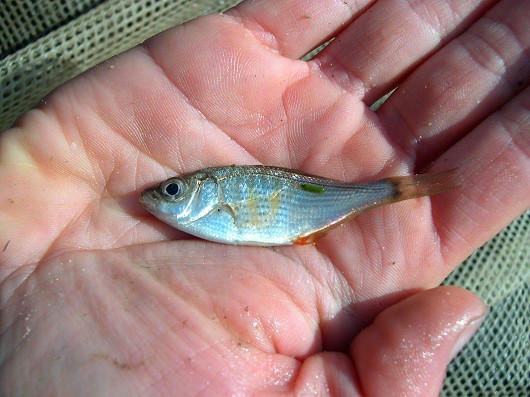Shiner Perch
-
Scientific NameCymatogaster aggregata
-
NativeNative Species
-
Identification
 Shiner perch, captured from Edison Canal, Ventura County, CA on 15 December 2005. Photo by Steve Howard.
Shiner perch, captured from Edison Canal, Ventura County, CA on 15 December 2005. Photo by Steve Howard.- Maximum size 235 mm FL
- Fairly deep bodied
- Silver to gray coloration, 3 yellow vertical bars, fine horizontal bars
- Breeding males turn dark, bars obscured by speckling
- Fin rays/spines: dorsal 8-9 spines/18-23 rays, anal 3 spines/22-25 rays, pectoral 19-21 rays, pelvic 1 spine/5 rays
- Lateral line scales: 36-46
-
Life History
Shiner perch live in marine, bay, and estuarine environments. They are found in waters with salinities ranging from 0-35 ppt, though shiner perch typically prefer a salinity of at least 10 ppt. At the mouth of a river, younger fish are found upstream of the older ones, as they have a greater tolerance for freshwater. Favorable surf perch water is generally less than 19°C with a potential range of 7-26°C. Shiner perch are rarely found in water with a temperature that exceeds 24-25°C. They move around a bay or estuary in response to flow regimes and reproductive needs. During winter or periods of high river flow surf perch move to the ocean whereas they move into the estuary during the summer breeding season. Within the estuary they feed mostly on zooplankton such as copepods, while in a river they may feed on amphipods and midge larvae. Juvenile shiner perch feed throughout the day and night whereas adults feed mostly during the day. Food consumption may change as opportunities arise. Breeding in shiner perch involves courtship and mating, and leads to the live-birth of 3-4 cm perch. Between March and May perch move into shallow water areas where the female fish first gives birth and then mates again. One female fish may hold the sperm of several males as the eggs develop within her. In November to December the eggs are fertilized and 4-6 months later the female returns to bear young again. Body size is positively correlated with the number of young born. Young shiner perch form shoals and remain in shallow water areas where food and protection form predators may be in greater supply. They grow most rapidly in the first year of what is typically a 2 year life. Shiner perch may live up to 7 years.
-
Links to Other ResearchN / A
-
Watershed
-
Alisal-Elkhorn Sloughs Watershed
-
Aliso-San Onofre Watershed
-
Big-Navarro-Garcia Watershed
-
Bodega Bay Watershed
-
Calleguas Watershed
-
Carmel Watershed
-
Central Coastal Watershed
-
Chetco Watershed
-
Cottonwood Tijuana Watershed
-
Coyote Watershed
-
Gualala-Salmon Watershed
-
Los Angeles Watershed
-
Lower Eel Watershed
-
Lower Klamath Watershed
-
Lower Sacramento Watershed
-
Mad-Redwood Watershed
-
Mattole Watershed
-
Newport Bay Watershed
-
Pajaro Watershed
-
Russian Watershed
-
Salinas Watershed
-
Salmon Watershed
-
San Antonio Watershed
-
San Diego Watershed
-
San Francisco Bay Watershed
-
San Francisco Coastal South Watershed
-
San Gabriel Watershed
-
San Joaquin Delta Watershed
-
San Lorenzo-Soquel Watershed
-
San Luis Rey-Escondido Watershed
-
San Pablo Bay Watershed
-
Santa Ana Watershed
-
Santa Barbara Coastal Watershed
-
Santa Clara Watershed
-
Santa Margarita Watershed
-
Santa Maria Watershed
-
Santa Monica Bay Watershed
-
Santa Ynez Watershed
-
Seal Beach Watershed
-
Smith Watershed
-
Suisun Bay Watershed
-
Tomales-Drake Bays Watershed
-
Ventura Watershed
-
Please note, watersheds are at the USGS 8-digit Hydrologic Unit Code (HUC) scale, so they often include a lot of sub-watersheds. If a species occurs in any sub-watershed within the HUC, the species appears within the HUC. Link to an EPA page that shows HUCs.
